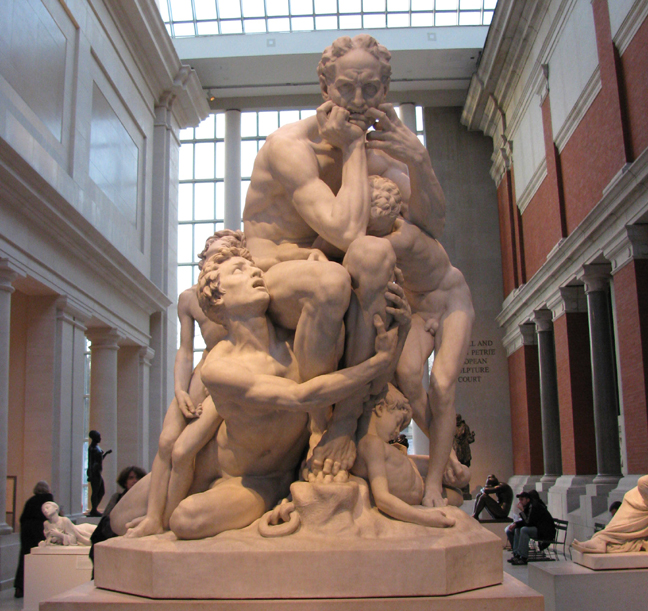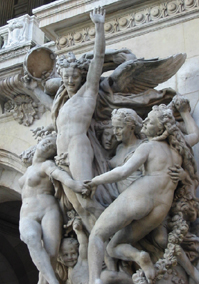
While visiting the Metropolitan Museum of Art during a recent trip to New York, I came across three narrative sculptures created by great French sculptors Jean-Baptiste Carpeaux, Auguste Rodin, and Antoine Bourdelle.
Ugolino and His Sons / Ugolin et ses fils
Jean-Baptiste Carpeaux (1827-1875)
Marble of 1865-1867 based on plaster model of 1860-1861
The story for this sculpture is derived from Dante’s Divine Comedy, specifically a story from Inferno in which Dante encounters in his travels through hell the soul of Ugolino della Gherardesca.
Ugolino’s soul has arrived in the betrayal circle of hell following his decades of involvement in the many bloody political struggles within and among the city states of 13th-century Italy. After Ugolino’s power in Pisa has definitively been overthrown and captured, Ruggieri, Archibishop of Pisa, accuses Ugolino of treachery and orders him, his sons, his grandsons thrown into prison, where they are abandoned, the key thrown into the river.

There in prison Ugolino would watch his descendants die one by one of starvation, and, starving himself, and at his sons’ urgings to put an end to their suffering, he would eat their flesh before dying himself of starvation. As the soul of Ugolino tells it, “I threw myself, screaming and crawling, over their lifeless bodies, calling them two days after they died, and calling them again, until hunger extinguished in me what pain had left.”
 The soul of Ugolino tells Dante this story as he continues to suffer his subsequent punishment in a special circle in hell reserved for betrayers of various kinds. There, two souls, Ugolino and Archbishop Ruggieri, are for eternity cramped together in a frozen hold from which only their necks and heads emerge and where Ugolino constantly gnaws away at Ruggieri at the place “where the brain meets the nape.”
The soul of Ugolino tells Dante this story as he continues to suffer his subsequent punishment in a special circle in hell reserved for betrayers of various kinds. There, two souls, Ugolino and Archbishop Ruggieri, are for eternity cramped together in a frozen hold from which only their necks and heads emerge and where Ugolino constantly gnaws away at Ruggieri at the place “where the brain meets the nape.”
A bronze version of this, cast in 1863 and originally placed in the Tuileries Garden, is now found in the Orsay Museum.
Carpeaux is also the sculptor of the joyful and seductive grouping of figures called “Dance” on the Garnier Opera in Paris (photo right).
The Burghers of Calais / Les Bourgeois de Calais
August Rodin (1840-1917)
Bronze of 1920s based on plaster cast completed in 1889
Rodin a successor to Carpeaux in the French sculptor hall of fame, also made his own version of Ugolino, which can be see in its monumental version in the ornamental pool at the back of the garden of Paris’s Rodin Museum and in a muddled miniature version on the Gates of Hell, a work inspired by Rodin’s passion, even obsession, for Dante’s Inferno.
Rodin’s greatest public sculpture, however, is The Burghers of Calais. The scene here is a historical event during the Hundred Years’ War between England and France.
For 11 months from 1346 to 1347 the English army of Edward III laid siege to the port town of Calais (the closest point between England and France, where the Chunnel now arrives). Aware that the town would starve to death if the siege continued, the commander of the garrison at Calais attempted to negotiate with the English, offering to surrender the town to the English if the Edward III were to agree to spare the population.

But Edward III wanted some form of vengeance of the trouble of laying siege for so long. He therefore offers to spare the town on the condition that six town leaders, or burghers, stripped of hats and shoes and any symbols of power and wealth, are brought to him bearing the keys of the city and with the rope with which they will be hung wrapped around their necks.
Rodin depicts the six men isolated in thought and movements, with each expressing a different mindset and stance with respect to despair, yet collectively they present a sense of ultimate patriotic sacrifice. And there’s amazing hand raised in a question that draws the viewer around to the back of work
Though the men are depicted as they are headed toward their individual and collective deaths, they were in fact spared. It’s said that Edward III’s queen Philippa stepped in at the last minute and begged the king to spare the lives of such heroic men willing to sacrifice themselves for the survival of their fellow citizens.
This intensely expressive and moving work was created to be placed in front of Calais’s City Hall, where the original was inaugurated in 1895. A number of copies were made after Rodin’s death, including this one at the Met and another at the Rodin Museum in Philadelphia. Another copy stands in the Rodin Museum in Paris, which occupies the mansion and garden where Rodin worked and lived when in Paris beginning in 1908.
Hercules the Archer / Héraklès archer
Antoine Bourdelle (1861-1929)
Bronze of 1920s based on original plaster model of 1909
Antoine Bourdelle studied with Rodin and began making a name for himself in the early 1900s as he began to purify and simplify his forms. He has created in this, his most celebrated work, a remarkably balanced tension in which the viewer anticipates the unleashing of Hercules’s arrow.

The story here is that of Hercules’s sixth labor.
Driven mad the goddess Hera, Hercules killed his children in a fit of madness, a.k.a. temporary insanity. As penance, he was told by the oracle to serve King Eurystheus and perform for him ten labors, two of which where eventually considered invalid and so finally amounting to twelve.
His sixth labor was to eradicate the flock man-eating birds that had the lake near the city of Stymphalus. Hercules used god-made castanet-like noisemakers to scare the Stymphalian birds into flight then shot them down with his bow and arrow.
There are a number of bronze versions of this around the world. The one in France’s national collection is in the Orsay Museum. A plaster version is in the Bourdelle Musem which occupies the studios and home where Bourdelle worked and lived in Paris’s Montparnasse Quarter from 1885 on.
– Photos and text by GLK

